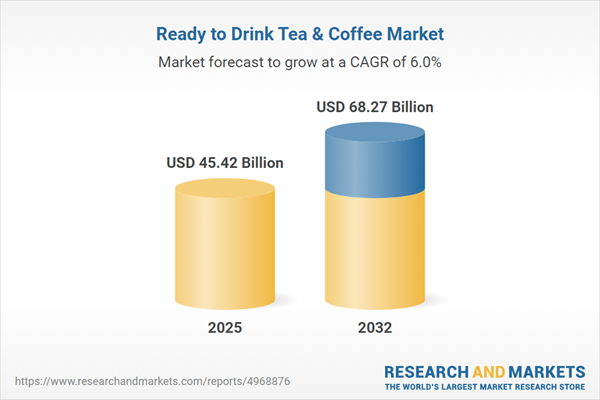Speak directly to the analyst to clarify any post sales queries you may have.
The ready-to-drink tea and coffee market is undergoing substantial change, marked by evolving consumer preferences, stricter regulations, and advancements across distribution and packaging. Senior executives in this space face an increasingly complex landscape, with new challenges and opportunities influencing strategies for growth and long-term relevance.
Market Snapshot: Ready-to-Drink Tea and Coffee Market Size and Growth Trajectory
In 2024, the global ready-to-drink tea and coffee market reached a value of USD 42.79 billion, on track to increase to USD 45.42 billion by 2025. The sector is exhibiting a compound annual growth rate of 6.01%, propelled by mounting demand for convenient and wellness-oriented beverages. High levels of competition are driving businesses toward focused innovation in both product development and packaging solutions. Industry leaders deploy advanced distribution models to build brand loyalty and set themselves apart, yet they must also adapt to new regulations and shifting consumer behaviors across all regions.
Scope & Segmentation: Comprehensive Market Coverage
- Product Types: Portfolio depth spans black coffee, cold brew, lattes, frappes, as well as black, green, herbal, and fruit-infused teas, reflecting both daily consumption trends and premiumization strategies across global markets.
- Packaging Varieties: Glass bottles, PET bottles, aluminum cans, and cartons are offered in both single-serve and multi-serve formats, supporting convenience and enabling brands to align with sustainability goals in diverse retail settings.
- Ingredient Formats: Regular and decaffeinated blends, including clean-label recipes and wellness-oriented formulations, respond to rising transparency expectations and the unique compliance needs of regulated consumer markets.
- Caffeine Levels: Ranges from high to low caffeine, supporting a personalized beverage experience and catering to distinct consumer tastes and regional consumption habits.
- Distribution Channels: Multi-channel strategies encompass supermarkets, hypermarkets, convenience stores, cafes, restaurants, e-commerce, and vending machines, allowing comprehensive market access and supporting omnichannel growth plans.
- Geographic Regions: The Americas, Europe, Middle East, Africa, and Asia-Pacific each present distinct consumption drivers, regulatory priorities, and operational dynamics, requiring adaptable approaches to positioning and compliance.
- Key Companies Profiled: Nestlé S.A., The Coca-Cola Company, PepsiCo Inc., Suntory Beverage & Food Limited, Keurig Dr Pepper Inc., Starbucks Corporation, Arizona Beverage Company LLC, Ito En Ltd., JDE Peet's N.V., and Monster Energy Company are central players, shaping category innovation and global supply standards.
Key Takeaways for Senior Decision-Makers
- Launching wellness-focused and premium products presents a pathway to enhance brand identity and cultivate loyalty among increasingly health-minded buyers.
- Transitioning to sustainable and traceable packaging formats is becoming essential to meet regulatory requirements and rising stakeholder expectations on environmental responsibility.
- Investing in digital and direct-to-consumer channels boosts engagement, while shifting online buying habits are influencing both product range and logistics strategies for beverage providers.
- Adopting clean-label formulations supports greater transparency and can elevate a brand’s standing on environmental, social, and governance metrics important to corporate buyers.
- Employing analytics and agile development methodologies accelerates responsiveness to shifting demand and evolving packaging trends across different markets.
- Tailoring regional innovation and compliance strategies can help companies better manage regulatory variability and sustain stable performance across diverse jurisdictions.
Tariff Impact: Navigating Policy Developments
As the industry prepares for anticipated U.S. tariffs in 2025, manufacturers are reassessing supply chain and sourcing decisions, particularly for essential raw materials like green coffee beans and specialty teas. Strategic efforts now emphasize building resilient regional networks, strengthening supplier relationships, and diversifying production bases. These steps enable market leaders to reduce exposure to global trade adjustments and better maintain operational continuity despite policy shifts.
Methodology & Data Sources
This analysis unites robust quantitative market data, in-depth interviews with executives, collaborative input from retail partners, and fresh consumer surveys. Third-party validation further ensures findings are actionable, timely, and accurately reflect the dynamics of the ready-to-drink tea and coffee category.
Why This Report Matters for Industry Leaders
- Enables strategic portfolio and innovation planning by presenting insights and best practices for sustainable growth within an evolving technology and consumer environment.
- Equips executive teams to anticipate regulatory, technological, and operational risks, enhancing the ability to respond to global shifts with confidence.
- Offers a reliable foundation for informed decisions by contextualizing competitive threats and emerging opportunities across markets.
Conclusion
Senior executives will find focused intelligence in this report to help navigate ongoing sector shifts, underpin informed strategy, and reinforce resilience in the ready-to-drink tea and coffee market.
Additional Product Information:
- Purchase of this report includes 1 year online access with quarterly updates.
- This report can be updated on request. Please contact our Customer Experience team using the Ask a Question widget on our website.
Table of Contents
3. Executive Summary
4. Market Overview
7. Cumulative Impact of Artificial Intelligence 2025
Companies Mentioned
The companies profiled in this Ready to Drink Tea & Coffee market report include:- Nestlé S.A.
- The Coca-Cola Company
- PepsiCo, Inc.
- Suntory Beverage & Food Limited
- Keurig Dr Pepper Inc.
- Starbucks Corporation
- Arizona Beverage Company, LLC
- Ito En, Ltd.
- JDE Peet's N.V.
- Monster Energy Company
Table Information
| Report Attribute | Details |
|---|---|
| No. of Pages | 196 |
| Published | October 2025 |
| Forecast Period | 2025 - 2032 |
| Estimated Market Value ( USD | $ 45.42 Billion |
| Forecasted Market Value ( USD | $ 68.27 Billion |
| Compound Annual Growth Rate | 6.0% |
| Regions Covered | Global |
| No. of Companies Mentioned | 11 |









